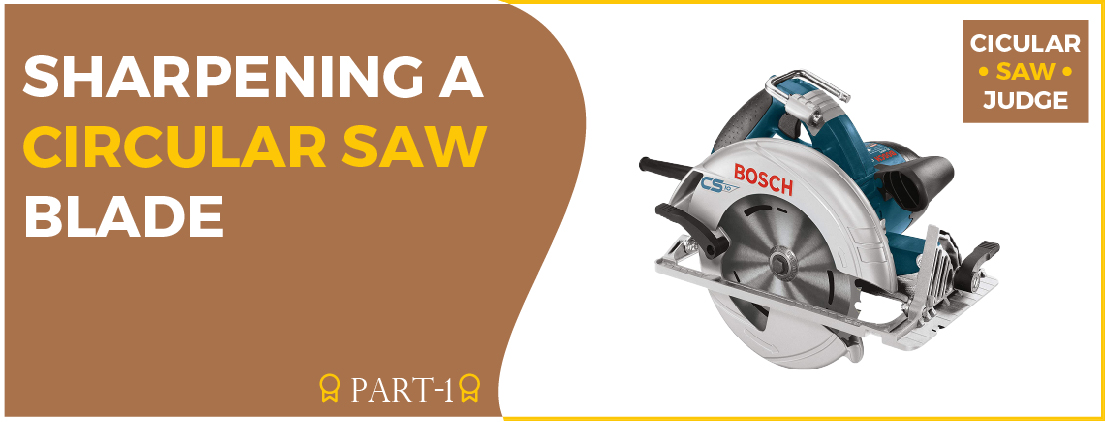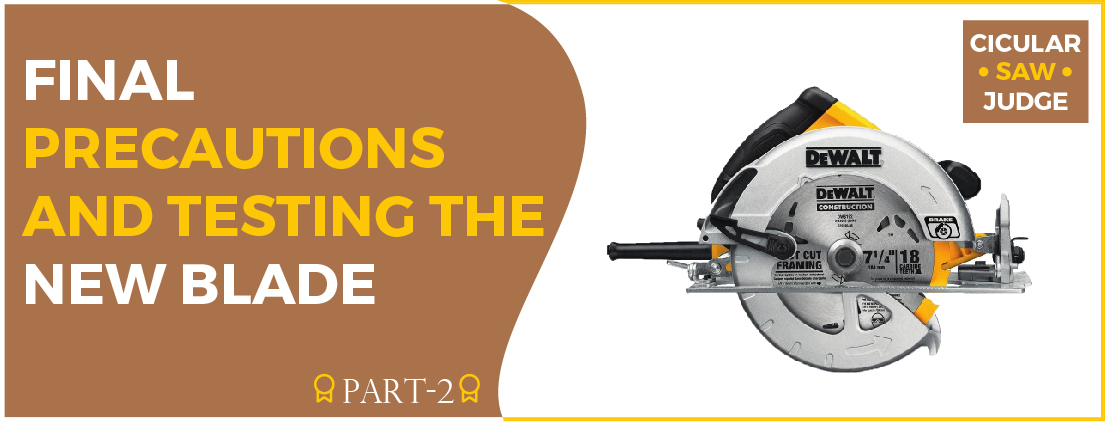How to sharpen a circular saw blade is a very challenging task, especially for beginners. The blade is a risky thing to be honed, whether you are professional or unprofessional. World widely, several people use a circular saw for performing their works, and the necessity to refine circular saw blade is significant.
An old and reared saw will make your work troublesome and will give you a dull complexion. If you want a perfect edge of your blade with ideal cutting, stick to the guidelines and precautions, the blade edge improvement will not make a big deal anymore.
Here we will discuss some points necessary for sharpening a circular saw blade in detail:
- Precautionary measures.
- Carbide edge cutting blades and its problems.
- Types of teeth in the circular saw blades.
- Requirements.
- Steps of sharpening the circular saw blade
- Conclusion
Circular saw titled the most dangerous saw among all. So, firstly, take the preventive measures before you hone the circular saw blade. We are looking forward to helping you with all your queries on circular saw judge. We are mentioning it again to intensify its seriousness.
Preventive measures:
I will advise the utilization of all the precautionary measures before sharpening a circular saw blade. For circular saw, the protective measures are more than essential because health is wealth.
Follow the given instructions:
- Safety goggles: Goggles stop the dust going into your eye and provide clearer vision.
- Hearing protection equipment: Using these, aid your ears with noise protection
- Wearing proper clothes: It would shield you from flames and dirt. For sharpening the blades, Snug-fitting clothing is a better option. If it’s not available, you can also use tight-fitting but flexible clothing.
- Do not drink alcohol: As consciousness promise you a stronger grip.
- Show attentiveness during work: The more concentrated you are, the faster you work.
- Power disconnection: This is an essential thing which can reduce severe accidents during work.
- Observe the blade: Be careful of the sawdust.
However, there is a blade known as a carbide blade. This edge is not an ordinary blade. It needs expertise while dealing with it. Current and latest saws are tipped with carbide or precious stone, namely diamonds, making it difficult for certain individuals to get familiar with the ability to make a circular saw blade sharp and intense.
If you are dealing with carbide edged blades, be careful because of these accompanying reasons listed below:
- Carbide is an extreme metal that requires being intensified, utilizing a precious stone wheel known as the diamond wheel. Honing turns out to be very perplexing, and the sharp edge can without much of a stretch be demolished.
- Carbide edges (blades) cut with the edges of teeth and margins, and if precautions one are ignored can without much of a stretch wreck the tips.
Two distinctive types of teeth:
Before honing the blades, be familiar with the types of circular saw blades.
The Rip teeth: These teeth are chisel-shaped and are honed (sharpened) by filling four-sided through the sharp edge.
Crosscut Teeth: These are blades molded and are shaped by filling at a point to the cutting edge.
Programmed sharpeners are not suggested as they would overheat or lose the right end of the teeth; they are sharpening. Manual sharpening consistently will give you the best outcome.
Tools that will help you to sharpen your circular saw blade:
Before honing the blades, be familiar with the types of circular saw blades.
- Hand file (A three-piece is highly suggested)
- Wrench sharpener
- Programmed sharpener
- A Marker or chalk or oil pencil
- Wire brush having a comfortable holder
- Gloves (are optional)
- A cloth for cleaning the surface
- Petroleum jelly
- A thin shredded wood
- Painter brush
- Bench vice
An ideal approach to sharp a circular saw blade is with a particular calibrated machine. Be that as it may, the majority of these machines are very costly and far off for the vast majority. So let’s do it the manual way. You can follow these same exact steps described below.
Table of Contents
1. Sharpening a Circular Saw Blade:
Detach from the power line before sharpening the sharp edge at home, separate the saw from the primary power connection if you are having a corded circular saw, or evacuate the battery if it is the battery power-driven or cordless circular saw.
Disconnect the sharp edge from the saw:
The latest circular saws have a device used for locking. This makes it simpler to withdraw the sharp blade from the saw. You don’t need to drag to release the screws that hold the sharp edge. It is almost similar to a switch system and trouble-free to operate. Additionally, clip the meager piece of wood to the saw bed and against the tooth. This shields the saw from turning while you detach the jolt that confines it in its place.
Choose the area of your work properly:
Select a working area and ensure that it is lightened. And also ensure that there may not be any kind of dirt or dust. Lightening is very necessary because you are dealing with the blade to be refined. This blade can physically damage you. And the process of sharpening needs to see the tooth of the blades.
Secure the sharp edge:
Apply the petroleum jelly to the edge and permit it to sit for about 20 to 30 minutes. This assists in breaking the latex in the teeth. Now fasten the blade into a vice clutch. Utilize the wire brush to clean it. Brushback to front up to the teeth. As you continue, the clothes will immerse the fine residue and remain. Permit the edge to confront upwards when the teeth face you. The tightening of the vice may damage the metal that grips the teeth.
Immerse the blade in the water:
Take a clean basin. Put in it some hot water. And then add a large amount of citrus oil soap in it. Continue adding the soap until the water contains a large proportion of soap and soap bubbles. Now dip the dull blade you have taken off from the circular saw in that water. Wait for about 15 to 30 minutes.
Take out the blade after a given time and dry it. As it dries, take the blade and rub it with a bristle brush to remove any kind of oil of dirt. Now leave the blade to dry completely.
Do the Markings:
Mark the first tooth by using a marker or chalk. The imprint should be evident. This makes it simple to find the end of the edge. This also saves time to sharpen the blade again and again. Accurate marking is significant is each and every work. This leads you to a definite goal. Ensure each two-blade points have an angle on that side that is confronting you. Incline the file at an angle of 20 degrees and hold it in place.
Make around four predictable strokes here and there along the angle of the principal tip. If not fruitful, apply more strokes or get another record.
Focus on the Bevels:
On every second blade, the inclinations appear. It’s essential to avoid one in the middle. Rehash this procedure until you get around the entire sharp edge. Apply an equivalent number of strokes as you did in the sharp primary edge.
Continue on another side:
Turn the cutting edge over once this is finished. Rehash the procedure by applying indistinguishable strategies. Make an imprint only like stage 6.
Filing of teeth:
The tips of every tooth should be filed. There is no compelling reason to apply numerous horizontal strokes to sharpen your blade. Run the file in a to-and-fro way over the front edge of the highest point of the blade point. This will guarantee you that you would not need to wear the blade down more than your requirement.
The best strategy to ace would be to sharpen one tooth and bypass the other one tooth. The process should be like ‘sharp and skip and sharp and skip and so on and on.
Sawteeth typically be inclined in various methods. One will grade to one side, for example, left while the other will slope to one side, for example, right. In this way, each blade inclines towards a direction opposite to each other.
Benefits of distinctive inclination:
- This typical manner in which the edge is inclined ensures a wider cut as compared to the width of the blade cutting it.
- Adjust the blade in the vice and file it until the tooth comes to the exact position in which it was initially present.
2. Final Precautions and Testing the Blade:
Evacuate the circular saw blade for the subsequent time:
Now turn the cutting edge in 180 degrees point and fix it once again into vice. Now repeat the process of sharpening the circular saw blades that were skipped for the last time.
This time adjust the file on the marked tooth and then file to and fro for a minimum four times. However, you can file multiple times according to your choice. For this time, you do not need to skip any single tooth.
Keep repeating this process of filing for all the teeth present. Keep filing until you get a sharpened blade-like shiny steel.
Precautions should be taken while performing the filing procedure. As if you listen to a screeching sound during filing. This sound will indicate to you that you are not filing correctly. If you hear a shrieking sound, it means you are not perfect in your work.
Clean the sharpened blade:
Once you finish sharpening the circular saw blade. Then, clean your blade in a basin with hot water and then wait for 15 minutes to dry. Utilize a delicate brush and a cloth to expel any leftovers that have remained on it before taking it back on the table saw.
Introduce the edge:
Remove the blade from the grip of a vice, and introduce it back onto the circular saw. Remember, this needs to be done evenly and carefully.
Give a sharpened blade a test:
After setting, the whole case of circular saw plugs in the cable for the circular saw having cable connection or put back the battery. Take the test wood. Have a test cut on it with this sharpened saw. If the test is pass, become ready to achieve your goal.
Circular Saw FAQs:
How much does it cost to sharpen a circular saw blade?
Price may vary depending upon the condition of your blade. Refining your blades to make them brand new, are charged per tooth. Sharpening a blade may cost up to 25 to 50 cents per tooth. You can also do this at home by a filer at a fairly less rate, but it is a lengthy work.
How do you sharpen a circular saw blade at home?
You can do that at home with a filer, but it may not work for every single blade. Beware of not refining your carbide blades at home because they are rather more complicated, and you may ruin your blades by filing its angles inaccurately.
How many times can you sharpen your circular saw blade?
It depends on the type of blade you have. Usually, a blade can be professionally sharpened several times in a three year period.
Which category can blades be sharpened?
Steel tooth blades can be sharpened with a filer, but carbide is to be done professionally. Moreover, do not bother to sharpen cheap blades; else, you will end up wasting your time. First, save them for cutting lumbers having nails hidden inside.
Conclusion:
All in all, you don’t need to take your circular saw to an expert. You can do it at home utilizing a file. “You will never have a dull moment with a dull blade.” You can sharpen the blades whenever you want. You just have to follow the precautions keenly. If you have know-how about the blades, which are meant to be sharpened, you can easily attain positive outcome from strenuous work. So, do not waste money and time in finding the best circular blades, first make it one.
Related Circular Reviews & Buyer’s Guide:
- Best Circular Saw 2022 Reviews – Top 13 Picks and Buying Guide
- Best Cordless Circular Saw 2022 Reviews – Top 9 Picks and Buying Guide
- Best Corded Circular Saw 2022 Reviews – Top 7 Picks and Buyer’s Guide
- Best Budget Circular Saw 2022 Reviews – Top 5 Picks and Buyer’s Guide
- Best Circular Saw for Home Use 2022 – Top 5 picks and Buying Guide



Leave a Reply